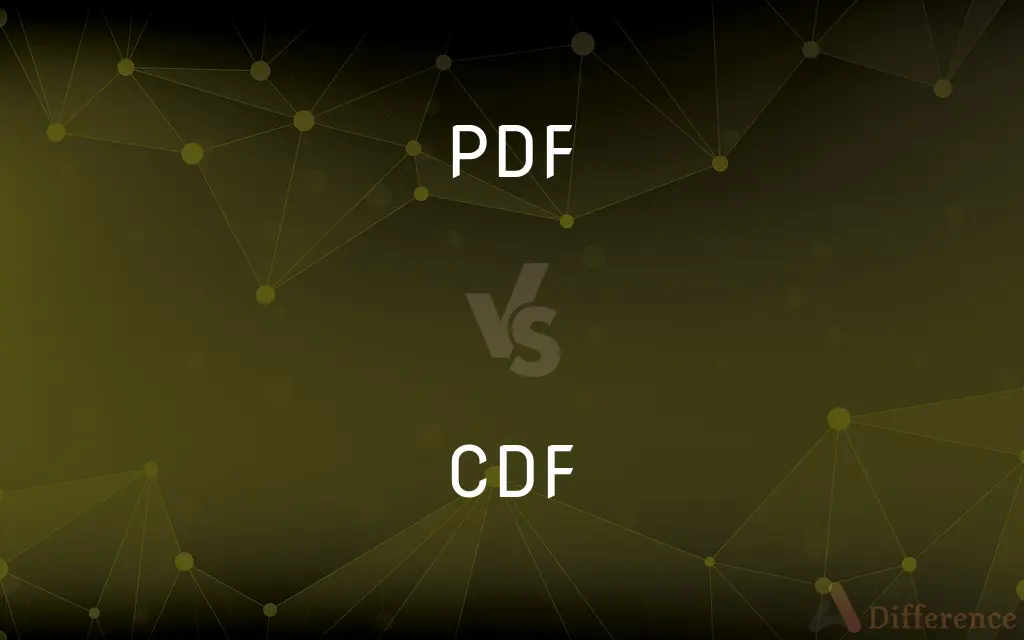PDF vs. CDF — What's the Difference?
Edited by Tayyaba Rehman — By Fiza Rafique — Published on December 23, 2023
PDF (Probability Density Function) describes the likelihood of a continuous random variable's value, while CDF (Cumulative Distribution Function) gives the probability that the variable is less than or equal to a certain value.

Difference Between PDF and CDF
Table of Contents
ADVERTISEMENT
Key Differences
The PDF, or Probability Density Function, is a statistical function that describes the likelihood or probability of a continuous random variable taking a specific value. The CDF, or Cumulative Distribution Function, on the other hand, provides the cumulative probability of a random variable being less than or equal to a particular value.
While both PDF and CDF are used to understand the behavior of random variables, their representations differ. The PDF shows the 'density' or how values of the random variable are distributed over a range, while the CDF shows the cumulative probability from the smallest possible value up to a given value.
It's important to note that the PDF always lies between 0 and 1 and will integrate to 1 over its entire range. The CDF starts at 0 and gradually increases, approaching 1 as it covers the entire range of possible values.
One can derive the CDF from the PDF by integration. Essentially, the CDF at any point is the integral of the PDF from negative infinity to that point. Conversely, the derivative of the CDF gives the PDF.
In summary, while both PDF and CDF describe the behavior of random variables, the PDF gives a snapshot of the probability at a specific value, and the CDF gives a cumulative perspective up to a specific value.
ADVERTISEMENT
Comparison Chart
Definition
Probability at a specific value
Cumulative probability up to a value
Range
Always between 0 and 1
Starts at 0 and approaches 1
Integration/derivation relation
Integral gives CDF
Derivative gives PDF
Visualization
Shows distribution density
Shows cumulative probability
Interpretation
Likelihood of variable's specific value
Probability variable is less or equal to a value
Compare with Definitions
PDF integrates to 1 over its entire range.
The area under the curve of the PDF always equals 1.
CDF
CDF can be derived from the integral of the PDF.
The slope of the CDF at a point indicated the PDF value.
PDF represents how values of a random variable are spread over its range.
The peak of the PDF indicated the most common weight in the dataset.
CDF
CDF represents the probability from the minimum value to a given value.
The CDF value at 5 inches indicated the percentage of measurements below that value.
PDF always lies between 0 and 1.
The PDF value cannot exceed 1 or be negative.
CDF
CDF starts at 0 and approaches 1 over its range.
As we moved right on the graph, the CDF value got closer to 1.
PDF can be used to understand distribution characteristics like mean and variance.
The skewness of the PDF showed an asymmetry in the data.
CDF
CDF provides the cumulative probability of a random variable.
The CDF showed a 90% chance of weights being below 200 pounds.
PDF is the probability density of a continuous random variable.
The PDF illustrated how heights were distributed among adults.
CDF
CDF gives a comprehensive view of the distribution.
The CDF provided insights into percentile rankings in the dataset.
Initialism of probability density functionCategory:en:Functions
Alternative case form of PDF
Common Curiosities
How is CDF different from PDF?
CDF provides the cumulative probability up to a value, while PDF gives the probability density at a specific value.
Can we derive PDF from CDF?
Yes, the derivative of the CDF gives the PDF.
What is the range of values for PDF?
PDF always lies between 0 and 1.
Can CDF decrease as we move along its range?
No, CDF is non-decreasing and only increases or remains constant.
Does CDF always start at 0 and end at 1?
Yes, CDF starts at 0 and gradually approaches 1.
Can discrete random variables have a PDF?
No, discrete random variables have a probability mass function (PMF) instead of PDF.
Why is the CDF useful in statistics?
CDF helps in understanding cumulative probabilities, percentiles, and quantiles in a distribution.
What's the area under the curve for a PDF?
The area under the PDF curve is always 1.
What does PDF represent in statistics?
PDF represents the likelihood of a continuous random variable taking a specific value.
What happens when you integrate the PDF over its range?
Integrating the PDF over its entire range gives a value of 1.
How can we visualize PDF and CDF?
PDF is typically visualized as a curve, while CDF is visualized as a non-decreasing curve starting at 0 and ending at 1.
Can PDF have values greater than 1?
Yes, for some distributions, but its integral over its range will always be 1.
Is CDF continuous for all distributions?
CDF is always continuous, even if the underlying distribution is discrete.
Can we find median using PDF or CDF?
Yes, the median can be found using CDF as the value where the CDF is 0.5.
How does CDF relate to percentiles?
The value of the CDF at a point is the percentile rank of that point in the distribution.
Share Your Discovery

Previous Comparison
NyQuil vs. DayQuil
Next Comparison
Oak Leaf vs. Maple LeafAuthor Spotlight
Written by
Fiza RafiqueFiza Rafique is a skilled content writer at AskDifference.com, where she meticulously refines and enhances written pieces. Drawing from her vast editorial expertise, Fiza ensures clarity, accuracy, and precision in every article. Passionate about language, she continually seeks to elevate the quality of content for readers worldwide.
Edited by
Tayyaba RehmanTayyaba Rehman is a distinguished writer, currently serving as a primary contributor to askdifference.com. As a researcher in semantics and etymology, Tayyaba's passion for the complexity of languages and their distinctions has found a perfect home on the platform. Tayyaba delves into the intricacies of language, distinguishing between commonly confused words and phrases, thereby providing clarity for readers worldwide.












































